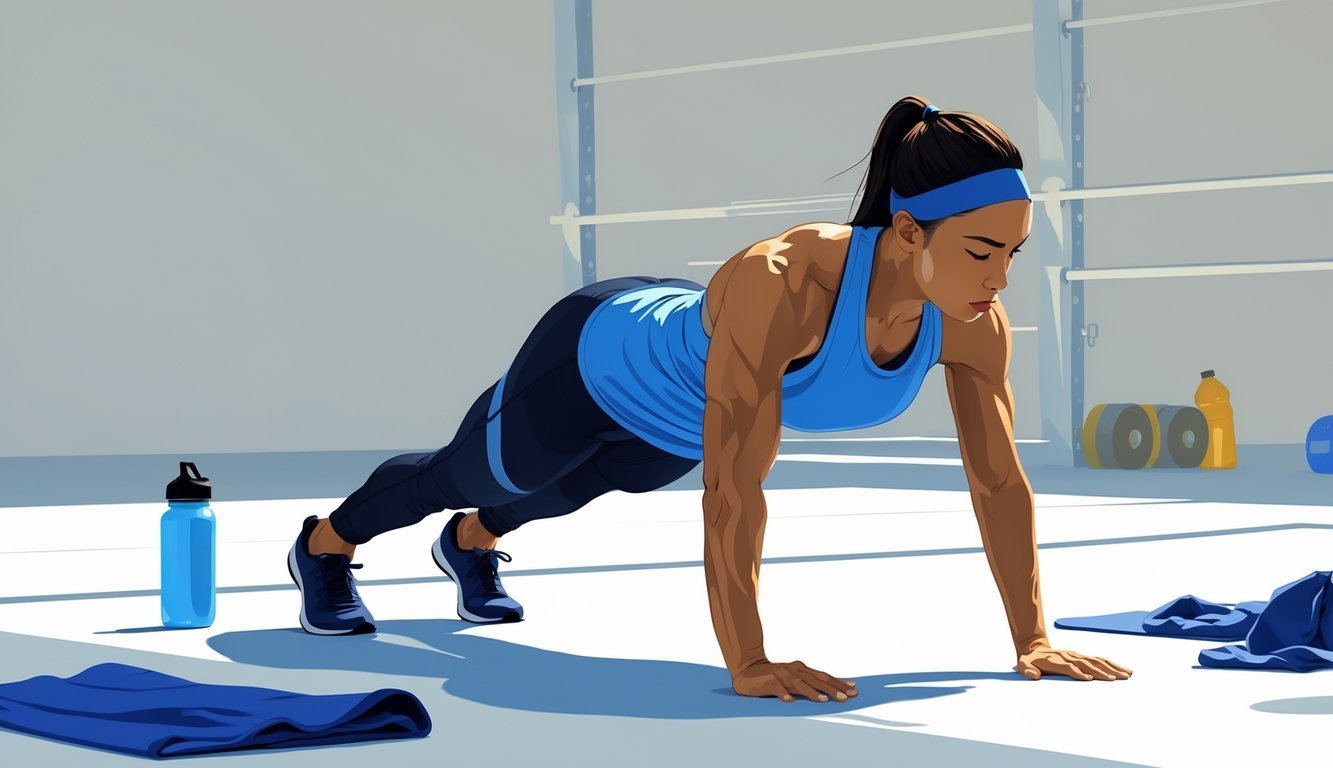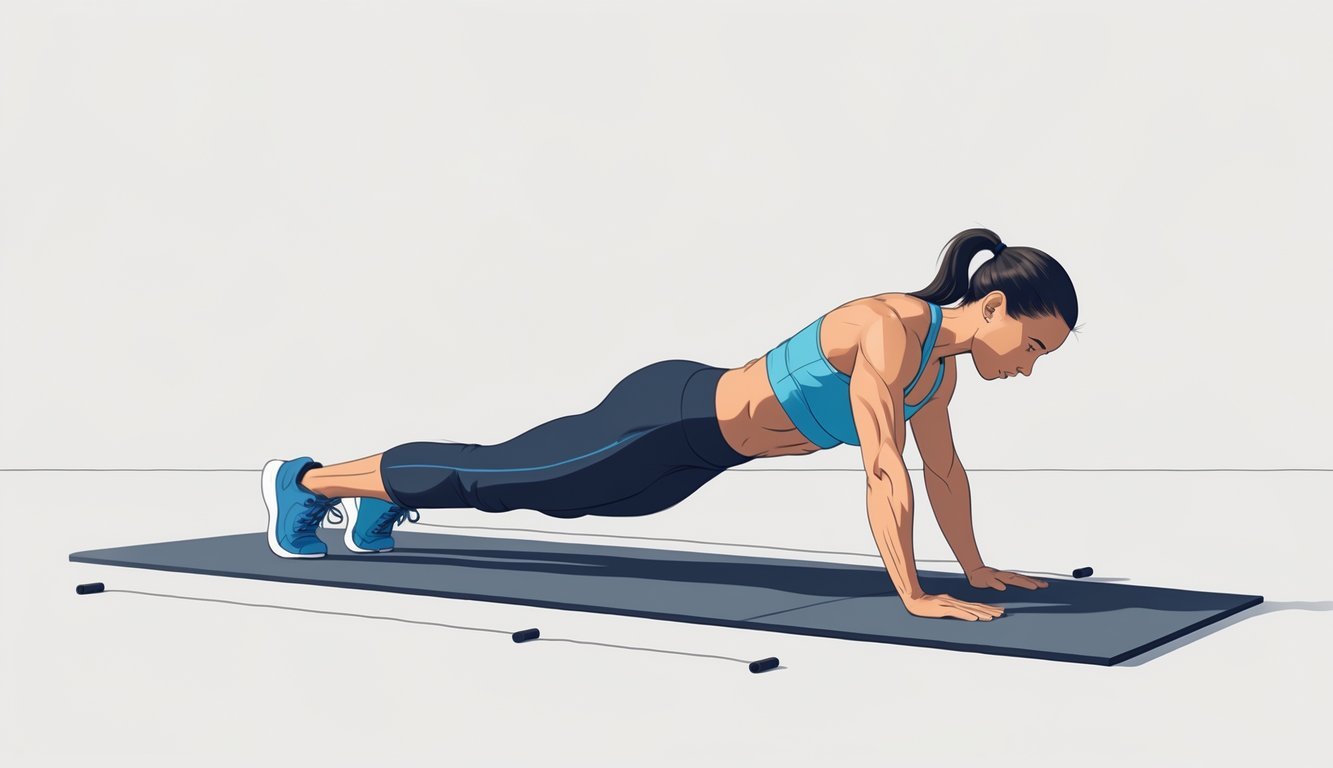Physical Address
304 North Cardinal St.
Dorchester Center, MA 02124
Physical Address
304 North Cardinal St.
Dorchester Center, MA 02124
Bodyweight exercises like push-ups, lunges, and burpees effectively prepare individuals for the Army Combat Fitness Test by building strength, endurance, and cardiovascular fitness without equipment.


Getting ready for the Army Combat Fitness Test (ACFT) can seem daunting, especially if you don’t have a gym or fancy equipment.
But honestly, it’s not as hard as it sounds.
You can build strength and boost your performance with no-equipment exercises that hit all the key movements in the test. Just use your body weight and a bit of creativity, and you’ll be able to train at home or wherever you happen to be.
This workout plan sticks to straightforward moves like squat jumps, lunges, and core work.
You’ll build the strength and endurance the ACFT demands.
You don’t need expensive gear to train well and make real progress.
If you keep things simple and stay consistent, you’ll get closer to passing that test.
So, ready to get started? Let’s jump in—no equipment necessary.


To get ready for the Army Combat Fitness Test (ACFT) without equipment, you’ll need a clear plan.
Focus on building strength, endurance, and power.
Make sure your plan covers all test events but keeps the workouts simple.
You’ll want to understand the test itself and figure out how to adapt each ACFT event with just your body and the space you have.
The ACFT tests six events: deadlift, standing power throw, hand-release push-ups, sprint-drag-carry, leg tuck or plank, and a two-mile run.
You get scored out of 100 points, and your minimum passing score depends on your rank and age.
Know what each event demands.
For example, the deadlift and sprint-drag-carry are all about strength and power.
Push-ups and the leg tuck test your muscular endurance.
The two-mile run is a straight-up test of your aerobic fitness.
You’ll need to train all these areas to do well.

With no weights, you’ll focus on bodyweight exercises that build strength and endurance.
Push-ups, planks, lunges, squats, and burpees all work well.
Mix up your sets, reps, and rest times to keep your body guessing.
Cardio matters, too.
Add running, sprint intervals, or shuttle runs to your week.
Always warm up first, and cool down with some stretches and water.
Don’t skip rest days—they help your body recover.
Stay consistent and aim for gradual progress.
Start with numbers you can handle, then add more as you get stronger.
Tracking your workouts helps you stay motivated and see your gains.
Some ACFT events need a little creativity if you don’t have gear.
Try a suitcase deadlift motion with a backpack or water jugs if you can find them.
If not, focus on good form.
For the standing power throw, practice explosive jumps or, if you have a medicine ball, give that a toss.
Vertical jumps work, too.
If hand-release push-ups are tough, stick with regular or knee push-ups.
Focus on moving through the full range of motion.
You can turn the sprint-drag-carry into timed shuttle sprints or some high-intensity intervals.
Just move fast and keep your rest short.
If the leg tuck isn’t possible or you don’t have a bar, work on planks to build core strength.
By adapting like this, you’ll still get ready for the ACFT, even with no equipment.

You can prep for the ACFT with just your bodyweight.
Simple movements can target the muscles and skills you need for each event.
Work on strength, core, and endurance.
Smart progressions and recovery keep you moving forward without injuries.
You’ll want to hit your arms, shoulders, core, glutes, and legs.
The ACFT really is a full-body test.
Push-ups build upper body strength for the hand-release push-ups.
Start with a number you can handle and add reps as you go.
Pull-ups or negatives help your arms and shoulders.
No pull-up bar? Try inverted rows under a sturdy table or door-frame rows.
Squats, lunges, and hip thrusts work your legs and glutes for the leg tuck and sprint-drag-carry.
Mix it up with sumo squats and forward lunges to hit different muscles.
Burpees and squat jumps add power and explosiveness.
They’ll also get your heart rate up—good for sprinting and shuttle runs.
You need a strong core for the leg tuck and plank.
Hit your trunk muscles with front planks and side planks.
Start with 20-30 second holds and build up over time.
Switch to side planks to work your obliques and balance.
Dynamic core moves like hanging leg raises or lying leg raises will hit your lower abs and hip flexors.
For endurance, do several sets with short rests instead of one super-long hold.
Stick with it—core work pays off in every ACFT event.
The two-mile run is all about heart and lungs.
Start with steady runs at a pace you can manage.
Mix in interval training—sprint for 100 meters, rest 30 seconds, repeat 5-8 times.
It’ll make you faster and boost your work capacity.
Increase your total running distance slowly.
Don’t go too hard too soon.
Bodyweight circuits with burpees and squat jumps also help your cardio and leg strength.
Try to run 3-4 times a week.
Give yourself time to rest and recover so you don’t burn out.
Recovery matters, especially when you’re training without equipment.
After workouts, stretch with moves like the overhead arm pull, rear lunge stretch, and thigh stretch.
It keeps your muscles loose.
Write down your sets, reps, and times.
Push yourself a bit more each week—add a set, do a few more reps, but keep your form sharp.
Alternate tough days with lighter sessions or rest.
Your body will thank you.
If you don’t have a pull-up bar, stick with negatives or try different row variations.
Adapt as you get stronger.
Staying active and focused will keep you moving forward, no gym required.

Training for the ACFT without equipment really comes down to bodyweight moves that build strength, endurance, and flexibility.
The right routine and steady practice will help you see results.
Push-ups, plank holds, burpees, and lunges all work for strength and endurance.
High knees and jumping jacks are great for cardio fitness.
These moves target the main muscles you’ll need for the test.
Stick with consistent workouts that mix strength and cardio.
Try Tabata-style intervals to get your heart rate up.
Focus on good form and make sure you rest enough to stay healthy.
A combo of push-ups, burpees, lunges, planks, and high knees in sets with short breaks works well.
Start with 3 rounds, then bump it up as you get stronger.
This approach builds both stamina and muscle.
Aim for 4 or 5 sessions each week.
Let your muscles rest a day or two so they can recover.
Consistency is what really drives progress when you don’t have equipment.
Begin with a 5-minute warm-up—jog in place or do jumping jacks.
Try 3 sets of 10 push-ups, 15 lunges per leg, 20 burpees, and a 30-second plank.
Finish with 3 sets of 30 seconds of high knees.
Tweak the reps if you need to.
Put quality first—don’t just chase reps.
Keep your rest breaks short; that way, you’ll really build up your endurance.
Try stretches like overhead arm pulls or lunges.
They’ll help you get more flexible, which honestly makes everything feel a bit easier.
Stick with your routine and jot down your progress.
It’s a simple trick, but it keeps you motivated when things get tough.
